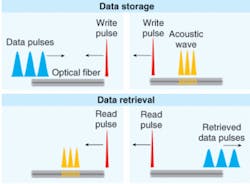OPTICAL MEMORY: Sound may offer ‘optical RAM’ solution
As optical networks become more ubiquitous and data-transfer rates increase, there is one component that is ever more conspicuous by its absence—optical memory. A promising and novel method has been shown to store optical data in the very medium that carries it: as a sound wave in standard optical fiber.
The conventional means for storing data in optical networks necessarily requires a conversion step, with a photodetector turning data into electronic signals that are stored in standard solid-state memory. A further conversion step at a later time uses a laser to convert the electronic signal back into an optical one. But both these steps generate heat and introduce potential errors-limitations that will likely become problematic with the exponential growth in data- transfer rates.
So why not skip the conversion steps? While methods exist for storing data optically, they generally require cryogenic temperatures and the manipulation of very delicate states of a soup of atoms, with the frequencies and bandwidths limited by the atomic system used as the storage medium.
Instead, Daniel Gauthier of Duke University and his colleagues have demonstrated a simple room-temperature approach that exploits the high nonlinearity of optical fibers. The method uses two pulses around 1.55 µm, the standard telecommunications wavelength, counterpropagating through standard silica optical fiber. One beam is a “write” pulse that carries no data. A “data” pulse, slightly detuned from the write pulse, interacts with the write pulse through stimulated Brillouin scattering (SBS). In this process, the spatially varying intensity of the pulses results in a spatially varying density, through an effect called electrostriction. The Brillouin scattering, mediated through the elasto-optic properties of the fiber, transfers a small portion of the energy of the input pulses into a slowly moving density wave in the fiber as the pulses pass. It is, in essence, a high-frequency sound wave with the data encoded on it (see figure).
At some later time, a “read” pulse is sent through the fiber, again with the “write” pulse, and the process is precisely reversed; a small amount of energy from the sound wave is then transferred through SBS onto the read pulse, which exits the fiber with data encoded on it.1
Better storage time
Pulses of 2 ns duration were stored reliably for times up to 12 ns-a far cry from the second-long storage times demonstrated in other approaches. But the team is convinced that by judicious choice of the fiber material—optimized for higher acoustic lifetimes—the approach could yield results that will make it a frontrunner for optical memory in the optical networking industry.
Using the material properties of the system for data storage represents a conceptual leap forward in optical memory solutions. “In its current form, we hope that these results are enabling in that they will get other people to think of new methods for storing optical information,” says Gauthier. “Our method shows that a different type of material excitation—an acoustic wave—can also be used to store information. We are certain that there are other material excitations that will also work.”
Ortwin Hess, at the University of Surrey’s Advanced Technology Institute (Guildford, England), calls the work a significant proof of principle and a clear contender as the system of choice for light storage. “The paper is a clear manifestation of the high interest in realizing the storage of light in condensed matter systems at room temperature,” says Hess.
Hess notes, however, that while this first demonstration is promising, one limiting factor is the amount of optical power needed for the input pulses—on the order of 100 W. Such high powers are necessary because the efficiency of the energy transfer at both stages of data transfer is still low. But Gauthier is convinced that the principle is sound and that optimization is simply a matter of finding the right material combinations. He has high hopes for smaller-core fibers to increase the power density, or other materials with higher SBS gain coefficients as the storage media. Candidates include chalcogenide fibers or hollow-core photonic-crystal fibers filled with liquids or high-pressure atomic gases.
Robert Killey of University College London thinks that if the method’s shortcomings can be surmounted, the optical memory dilemma could be resolved. “Researchers are starting to question the scalability of the conventional electronic approach as the capacity of future networks continues to increase, and hence there is significant interest in ‘optical RAM,’ ” Killey says. “If this could be made in a practical, low-cost form with low energy requirements, it would have a major impact on the design and operation of future optical packet-switched telecommunication networks.”
REFERENCE
1. Zhu et. al., Science 318, 1748 (2007).
